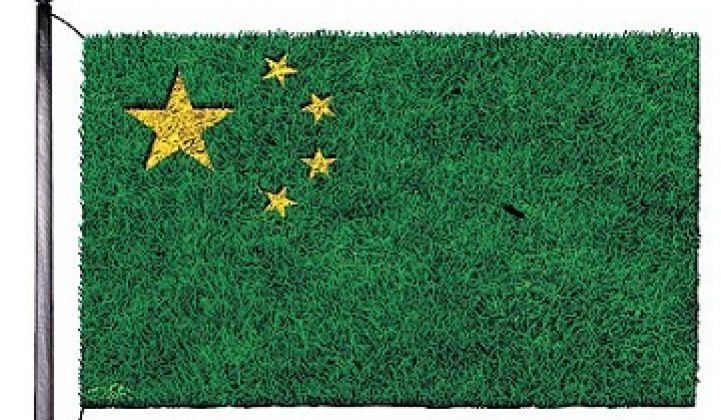China is now the world’s largest wind power market, according to the Global Wind Energy Council. In the very near future, China will also surpass the U.S. as the global leader in installed capacity.
The United States has expressed its excitement for China’s clean energy progress by requesting dispute settlement consultations through the World Trade Organization (WTO). This recent dispute stems from a 5,800-page petition filed by the United Steelworkers (USW) that claims, “China has utilized hundreds of billions of dollars in subsidies, performance requirements, preferential practices and other trade-illegal activities to advance its domination of the sector.”
The solar aspect of this dispute is covered here. While China maintains their policies are WTO-compliant, American companies claim they are still being shut out of the big red sandbox. Selling into China is not likely the Americans' main concern, but rather Chinese companies preparing to import wind energy products into the U.S.
Two programs targeted by the USW petition, ‘Ride the Wind’ and the ‘Export Research and Development Fund,’ have been discontinued. China has also agreed to amend requirements that foreign enterprises have experience supplying equipment to wind power projects in China and will now recognize work completed outside China as eligible experience. China has also relaxed some domestic content requirements. It seems China is being relatively amenable to the demands of the U.S., so why file the complaint?
The primary reason for the complaint is to stop the Special Fund for Wind Power Manufacturing. Grants available under this program can range from $6.7 million to $22.5 million -- the bigger the project, the larger the amount allotted. Recipients of these grants have been Chinese wind turbine and component manufacturers. According to the office of the U.S. Trade Representative (USTR), Chinese subsidies from this program have run into the hundreds of millions of dollars since its inception in 2008. The USTR claims that this violates WTO policy because the grants awarded seem to be dependent on Chinese wind power manufacturers using parts and equipment manufactured domestically. The USTR has also tacked on transparency-related claims and grievances stating that China has failed to translate program specifics into one of the official WTO languages. (The official languages are English, French and Spanish, but not Chinese, despite China being the world's largest exporter and second only to the U.S. in imports.)
By filing a complaint with the WTO, the U.S. and China now both have 60 days to resolve the dispute through diplomatic talks. Judging by the Commerce Ministry of China’s response, it is not likely there will be a resolution in two months’ time: "Every country in the world is seeking to develop renewable energy to cope with climate change. China's wind power measures are helping to save energy and protect the environment. This is crucial for sustainable development and is in accord with WTO principles." If a compromise cannot be reached in this 60-day period, the WTO will assemble a panel and review both sides’ arguments. If the U.S. wins its case, it could be authorized by the WTO to impose penalty tariffs on Chinese goods to make up lost revenue. Unfortunately, it may take up to a year for the case to be decided.
So what happens next? Here in the U.S., the wind industry had a rough year (down over 70% compared to 2009). However, development will likely continue due largely in part to the extension of the 1603 tax grant program. If U.S. development flounders, manufacturers want to ensure that they will have a market into which to sell their goods, which explains the USW’s petition and USTR’s complaints to the WTO. But will U.S. manufacturers really be shipping massive quanities of wind-related goods to China? Probably not.
In the time that it will take for the two countries to reach a compromise or for the WTO to hand down a decision, China’s wind industry will continue to grow and the its installed capacity will quickly surpass that of any other country in the world. Moreover, China's manufacturers will have had ample time to scale up production to compete with established companies. Then, as in the solar industry (see #2), Chinese producers will be able to sell into any market they choose. Watch your lunch, American wind energy companies.



